Splitting Tensile Mechanical Performance and Mesoscopic Failure Mechanisms of High-Performance Concrete under 10-Year Corrosion from Salt Lake Brine
Abstract
:1. Introduction
2. Materials and Methods
2.1. Raw Materials
2.1.1. Binding Materials
2.1.2. Aggregates
2.1.3. Admixtures and Water
2.2. Concrete Mix Proportion Design
2.3. Corrosive Environment
2.4. Testing Methodology
2.4.1. Ultrasonic Testing for Corrosion Damage—Flat Measurement Method
2.4.2. Split Tensile Test of HPC
2.4.3. HPC Surface Corrosion Product XRD Test
2.4.4. SEM-EDS Test of the HPC Microstructure
3. Results and Analysis
3.1. Damage Phenomena of HPC after 10-Year of Immersion in Brine
3.1.1. Macroscopic Damage Analysis
3.1.2. Microscopic Damage Analysis
3.2. Relative Dynamic Modulus and Corrosion Damage Issues
3.3. Splitting Tensile Mechanical Properties
3.3.1. Variation Law of Splitting Tensile Strength with Immersion Time
3.3.2. Variation in Splitting Tensile Strength with Alkali Content and Admixture
3.3.3. Splitting Tensile Strength and Relative Dynamic Elastic Modulus
4. Mesoscopic Mechanism Analysis of Splitting Tensile Failure of Concrete
4.1. The Establishment of the 3D Mesoscopic Model Based on FDEM
4.2. Material Model and Parameter Determination
4.2.1. K and C Model, HJC Model, and Cohesive-General Material Model
4.2.2. Determination of Material Model Parameters
4.3. The Verification of Simulation
4.4. The Meso-Mechanical Failure Process and Mechanism of Splitting Tensile
5. Conclusions
- (1)
- The macroscopic observation indicates that brine corrosion does not cause significant damage to the surface of HPC. The internal damage of HPC was studied by XRD and SEM-EDS analysis of Ca50Z-2 specimens immersed in salt water for 10 years. The results showed that XRD reveals corrosion products from salt lake brine and ASR corrosion products, primarily including AFt, Kuzel’s salt, Friedel’s salt, and CSH gel. Although these corrosion products do not cause serious damage to HPC, micro-cracks are generated due to the expansion of these products. SEM-EDS microstructure images show the propagation path of micro-cracks and the formation process of mortar cracks.
- (2)
- The variation in relative dynamic elastic modulus with HPC immersion time was studied. The results show that the relative dynamic elastic modulus “increases first and then decreases” with the extension of immersion time. Specifically, during the period of 0~365 days, the relative dynamic elastic modulus gradually increases by 4.01~17.36% with immersion time. From 365 days to 3650 days, the expansion of corrosion products leads to the structural damage of HPC and the formation of micro-cracks, thus reducing the relative dynamic elastic modulus, which is consistent with the results of microscopic analysis.
- (3)
- The splitting tensile strength of HPC was analyzed. The conclusion is that under the action of 10 years of salt lake brine corrosion, the splitting tensile strength of HPC with ASR inhibition measures exhibited a trend of initially increasing and then decreasing, which is consistent with the rule of Er with immersion time. The influence of alkali content on splitting tensile strength revealed a decrease as alkali content increased. A relationship between splitting tensile strength and Er was derived through fitting analysis. This relationship also reflects the relationship between macroscopic mechanical properties and corrosion damage of HPC, which serves as a theoretical reference for obtaining the macroscopic mechanical parameters of concrete through non-destructive tests in the future.
- (4)
- The utilization of the 3D random aggregate mesoscopic model enables the simulation of splitting tensile mechanical properties and facilitates the analysis of internal crack propagation characteristics and failure mechanisms. Microscopic structural analysis and numerical simulation elucidate that there are still uneven ASR gel products and discontinuous fine interface cracks induced in the local area of HPC with ASR inhibition measures, which become the origin of splitting tensile failure cracks. Overall, during the splitting tensile process of concrete, mortar cracks exhibit two expansion paths. For Ca60Z-2, the proportion of coarse aggregates directly penetrated by mortar cracks is 90.3%, while the proportion of interface failures of mortar cracks bypassing coarse aggregates is only 9.7%. The data indicate that the number of coarse aggregates directly through the mortar crack is higher than the number of interface damage that occurs when the mortar crack bypasses the coarse aggregate.
Author Contributions
Funding
Data Availability Statement
Conflicts of Interest
References
- Tan, B.; Okoronkwo, M.U.; Kumar, A.; Ma, H. Durability of calcium sulfoaluminate cement concrete. J. Zhejiang Univ. Sci. A Appl. Phys. Eng. 2020, 21, 118–128. [Google Scholar] [CrossRef]
- Taffese, Z.W.; Sistonen, E. Machine learning for durability and service-life assessment of reinforced concrete structures: Recent advances and future directions. Autom. Constr. 2017, 77, 1–14. [Google Scholar] [CrossRef]
- Hossain, M.M.; Karim, M.R.; Hasan, M.; Hossain, M.K.; Zain, M.F.M. Durability of mortar and concrete made up of pozzolans as a partial replacement of cement: A review. Constr. Build. Mater. 2016, 116, 128–140. [Google Scholar] [CrossRef]
- Tan, Y.; Wang, S.; Xu, F.; Liu, W.; Chen, X.; Liang, Y. Application of COMSOL Multiphysics in Research of Concrete Durability-A Short Review. J. Chin. Ceram. Soc. 2017, 45, 697–707. [Google Scholar] [CrossRef]
- Liu, L. Brief lntroduction on the Study of Erosion and Prevention of Concrete in Salt Lake and Saline Soil Area of Chaerhan, Chaidamu. J. Build. Mater. 2001, 4, 395–400. [Google Scholar]
- Venyite, P.; Nemaleu, J.G.D.; Kaze, R.C.; Tchamba, A.B.; Kamseu, E.; Melo, U.C.; Leonelli, C. Alkali-silica reactions in granite-based aggregates: The role of biotite and pyrite. Constr. Build. Mater. 2022, 320, 126259. [Google Scholar] [CrossRef]
- Ghiasvand, E.; Mohammadi, H.; Rezaei, Z.; Ayyoubi, M.; Dehghani, S. Evaluation of the durability of concretes containing alkali-activated slag exposed to the alkali-silica reaction by measuring electrical resistivity. Constr. Build. Mater. 2023, 367, 130094. [Google Scholar] [CrossRef]
- Kadhim, R.A.; Al-Taie, R.S.; Al-Mahaidi, R. Experimental and finite element analysis of mechanical behavior of concrete damaged by alkali aggregate reaction (AAR) and repaired with CFRP layers. IOP Conf. Ser. Mater. Sci. Eng. 2021, 1067, 012054. [Google Scholar] [CrossRef]
- Al-Rousan, R.Z. Cyclic behavior of alkali-silica reaction-damaged reinforced concrete beam-column joints strengthened with FRP composites. Case Stud. Constr. Mater. 2022, 16, e00869. [Google Scholar] [CrossRef]
- Huang, H.; Yuan, Y.; Zhang, W.; Zhu, L. Property Assessment of High-Performance Concrete Containing Three Types of Fibers. Int. J. Concr. Struct. Mater. 2021, 15, 39. [Google Scholar] [CrossRef]
- Saha, A.K.; Khan, M.N.N.; Sarker, P.K. The ASR mechanism of reactive aggregates in concrete and its mitigation by fly ash: A critical review. Constr. Build. Mater. 2018, 171, 743–758. [Google Scholar] [CrossRef]
- Harbec, D.; Zidol, A.; Tagnit, H.A. Mechanical and durability properties of high performance glass fume concrete and mortars. Constr. Build. Mater. 2017, 134, 142–156. [Google Scholar] [CrossRef]
- Li, L.; Ma, H.; Yu, H.; Zhang, J.; Cheng, M.; Wu, Z.; Yan, J.; Zhang, L.; Fan, H.; Wang, F. Attack resistance mechanism, uniaxial compressive mechanical properties and meso-simulation of high-performance concrete exposed to brine in salt lake for 10 years. Constr. Build. Mater. 2023, 407, 133520. [Google Scholar] [CrossRef]
- Yu, J.; Hu, M.; Yang, D. Damage research of C50 and C60 concrete under salt solution and load. Concrete 2015, 11, 17–20. [Google Scholar]
- Zhang, M.; Chen, J.; Lv, Y.; Wang, D.; Ye, J. Study on the expansion of concrete under attack of sulfate and sulfate–chloride ions. Constr. Build. Mater. 2013, 39, 26–32. [Google Scholar] [CrossRef]
- Cefis, N.; Comi, C. Damage modelling in concrete subject to sulfate attack. Frat. Ed Integrità Strutt. 2014, 8, 222–229. [Google Scholar] [CrossRef]
- Zhang, D.; Zuo, X.; Li, X. Coupling transmission model of chloride ion and sulfate ion in concrete. J. Civ. Eng. Manag. 2019, 36, 190–196. [Google Scholar] [CrossRef]
- Zhou, X.; Lu, D.; Du, X.; Wang, G.; Meng, F. A 3D non-orthogonal plastic damage model for concrete. Comput. Methods Appl. Mech. Eng. 2020, 360, 112716. [Google Scholar] [CrossRef]
- Lu, D.; Meng, F.; Zhou, X.; Zhuo, Y.; Gao, Z.; Du, X. A Dynamic Elastoplastic Model of Concrete Based on a Modeling Method with Environmental Factors as Constitutive Variables. J. Eng. Mech. 2023, 149. [Google Scholar] [CrossRef]
- Li, J.; Xu, Y.; Tian, Z.; Ma, J.; Jing, P.; Song, Z. Study on leaching damage mechanism of calcium ions of reactive powder concrete (RPC) under ion corrosion. Constr. Build. Mater. 2020, 269, 121303. [Google Scholar] [CrossRef]
- Jonny, N.; Rasoul, N. A Direct Tensile Strength Testing Method for Concrete from Existing Structures. CivilEng 2023, 4, 333–344. [Google Scholar] [CrossRef]
- Gautam, B.P.; Panesar, D.K.; Sheikh, S.A.; Vecchio, F.J. Effect of coarse aggregate grading on the ASR expansion and damage of concrete. Cem. Concr. Res. 2017, 95, 75–83. [Google Scholar] [CrossRef]
- Mehta, P.K. Studies on chemical resistance of low water/cement ratio concretes. Cem. Concr. Res. 1985, 15, 969–9978. [Google Scholar] [CrossRef]
- Ababneh, A.N. The Coupled Effect of Moisture Diffusion, Chloride Penetration and Freezing-Thawing on Concrete Durability. Ph.D. Dissertation, University of Colorado, Denver, CO, USA, 2002. [Google Scholar]
- GB/T 50081-2019; Ministry of Housing and Urban-Rural Development of the People’s Republic of China. Standard for Test Methods of Concrete Physical and Mechanical Properties. China Construction Industry Press: Beijing, China, 2019.
- Fang, Q.; Zhang, J. 3D numerical modeling of projectile penetration into rock-rubbk overlays accounting for random distribution of rock-rubble. Int. J. Impact Eng. 2014, 63, 118–128. [Google Scholar] [CrossRef]
- Fang, Q.; Zhang, J.; Zhang, Y.; Wu, H.; Gong, Z. A 3D mesoscopic model for the closed-cell metallic foams subjected to static and dynamic loadings. Int. J. Impact Eng. 2015, 82, 103–112. [Google Scholar] [CrossRef]
- Qin, F.; Zhang, J.; Yi, H.; Zhang, Y. The investigation into three-dimensional mesoscale modelling of fully-graded concrete. Eng. Mech. 2013, 30, 14–21. (In Chinese) [Google Scholar]
- Feng, L.; Chen, X.; Zhang, J.; Chen, C. Experimental and mesoscopic investigation of self-compacting rubberized concrete under dynamic splitting tension. J. Build. Eng. 2022, 57, 104942. [Google Scholar] [CrossRef]
- Zhang, J.; Zhang, Y.; Fang, Q. Numerical simulation of shock wave propagation in dry sand based on a 3D mesoscopic model. Int. J. Impact Eng. 2018, 117, 102–112. [Google Scholar] [CrossRef]
- Wriggers, P.; Moftah, S.O. Mesoscale models for concrete: Homogenisation and damage behaviour. Finite Elem. Anal. Des. 2006, 42, 623–636. [Google Scholar] [CrossRef]
- Malvar, L.J.; Crawford, J.E.; Wesevich, J.W.; Simons, D. A plasticity concrete material model for DYNA3D. Int. J. Impact Eng. 1997, 19, 847–873. [Google Scholar] [CrossRef]
- Holmquist, T.J.; Johnson, G.R. A computational constitutive model for concrete subjected to large strains, high strain rates, and high pressures. ASME J. Appl. Mech. 2011, 78, 051003. [Google Scholar] [CrossRef]
- Wang, F.; Yu, H.; Ma, H.; Chen, M.; Guo, J.; Guo, J.; Liu, W.; Gao, W.; Tao, Q.; Li, L. Mechanical Performance of The ITZ and Mesoscopic Compression Failure Mechanism of HPC with ASR Inhibition Measures under Long-term Brine Attack. Case Stud. Constr. Mater. 2024, 6, e00959, Prepublish. [Google Scholar]

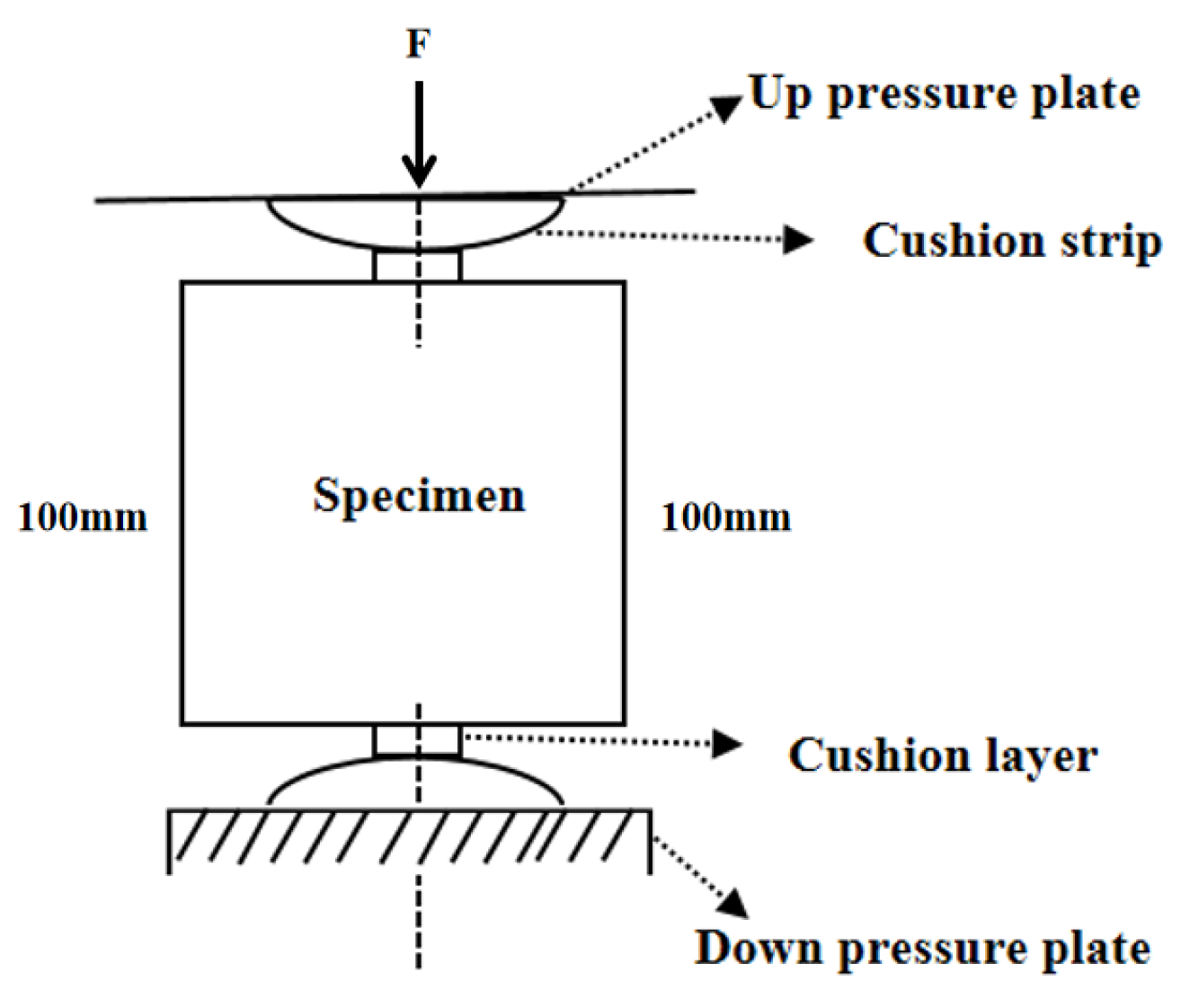
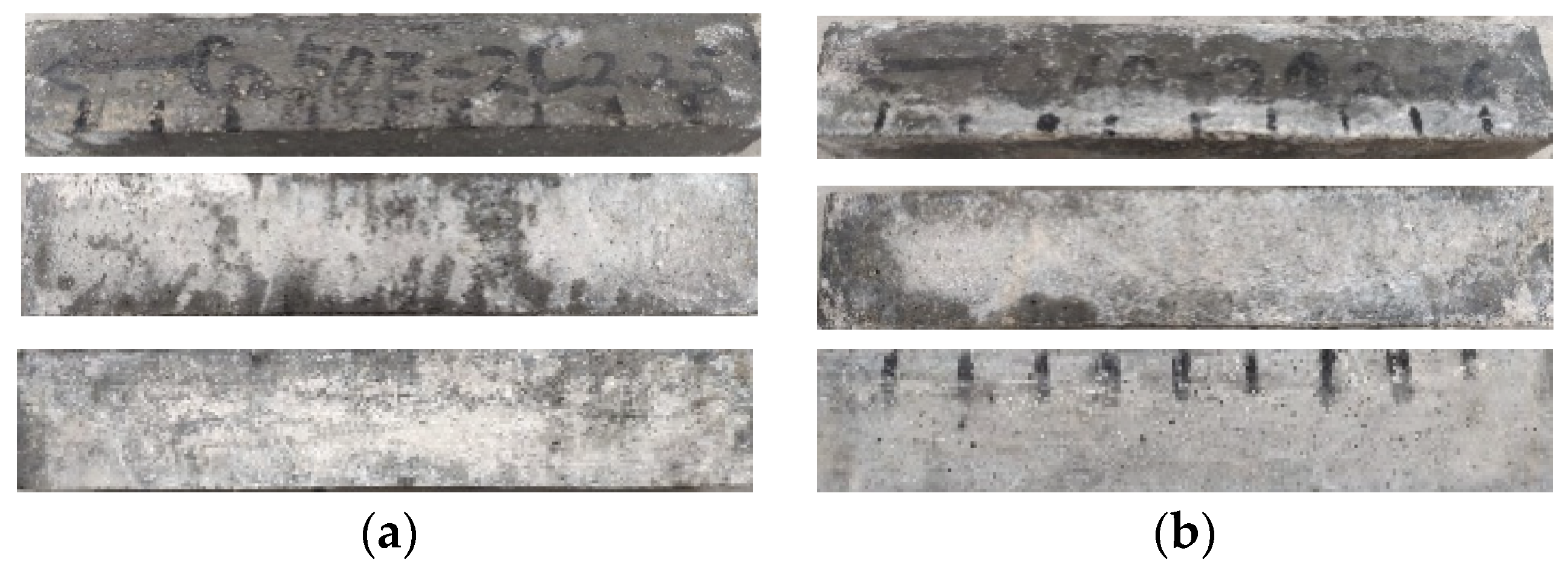
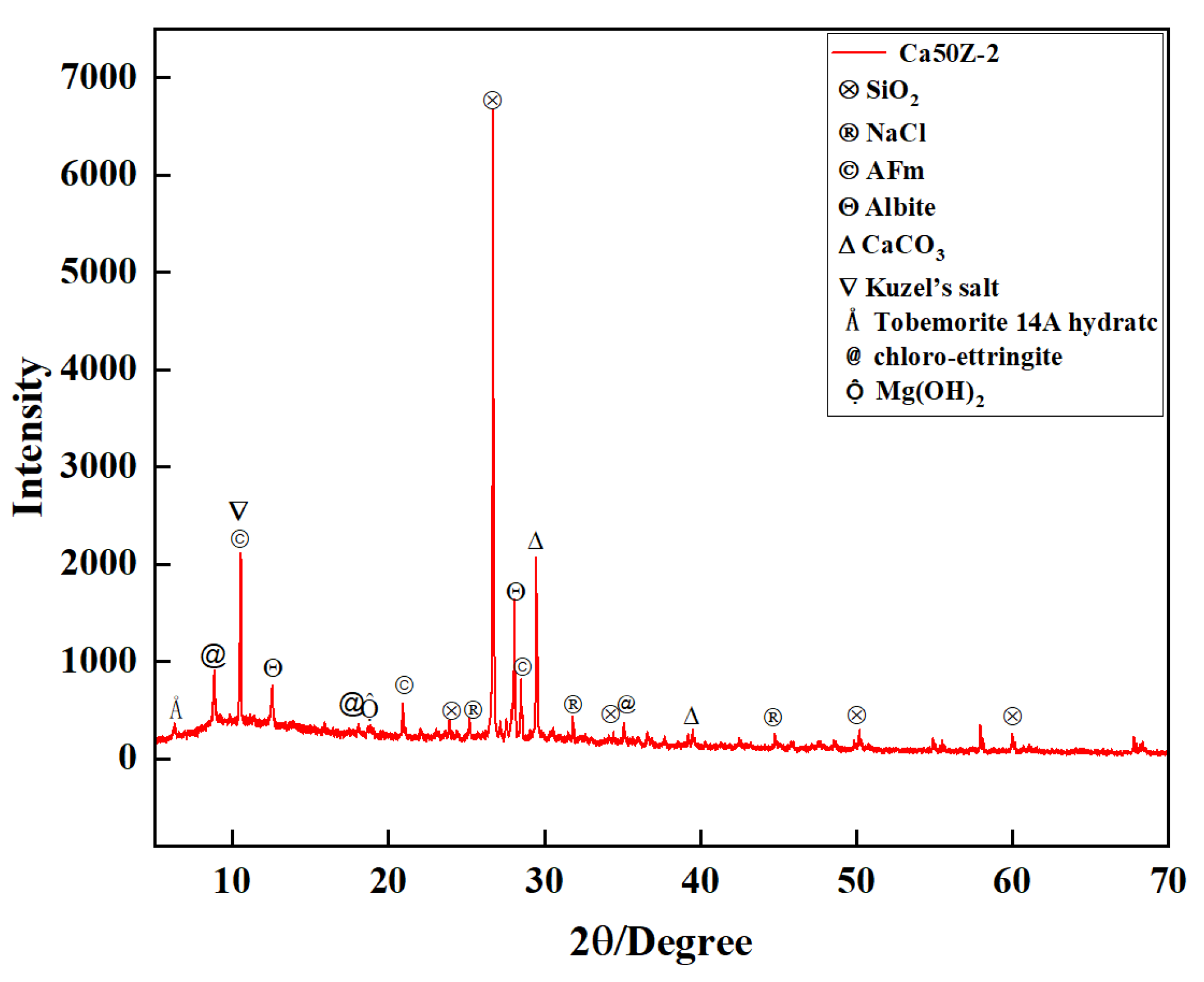
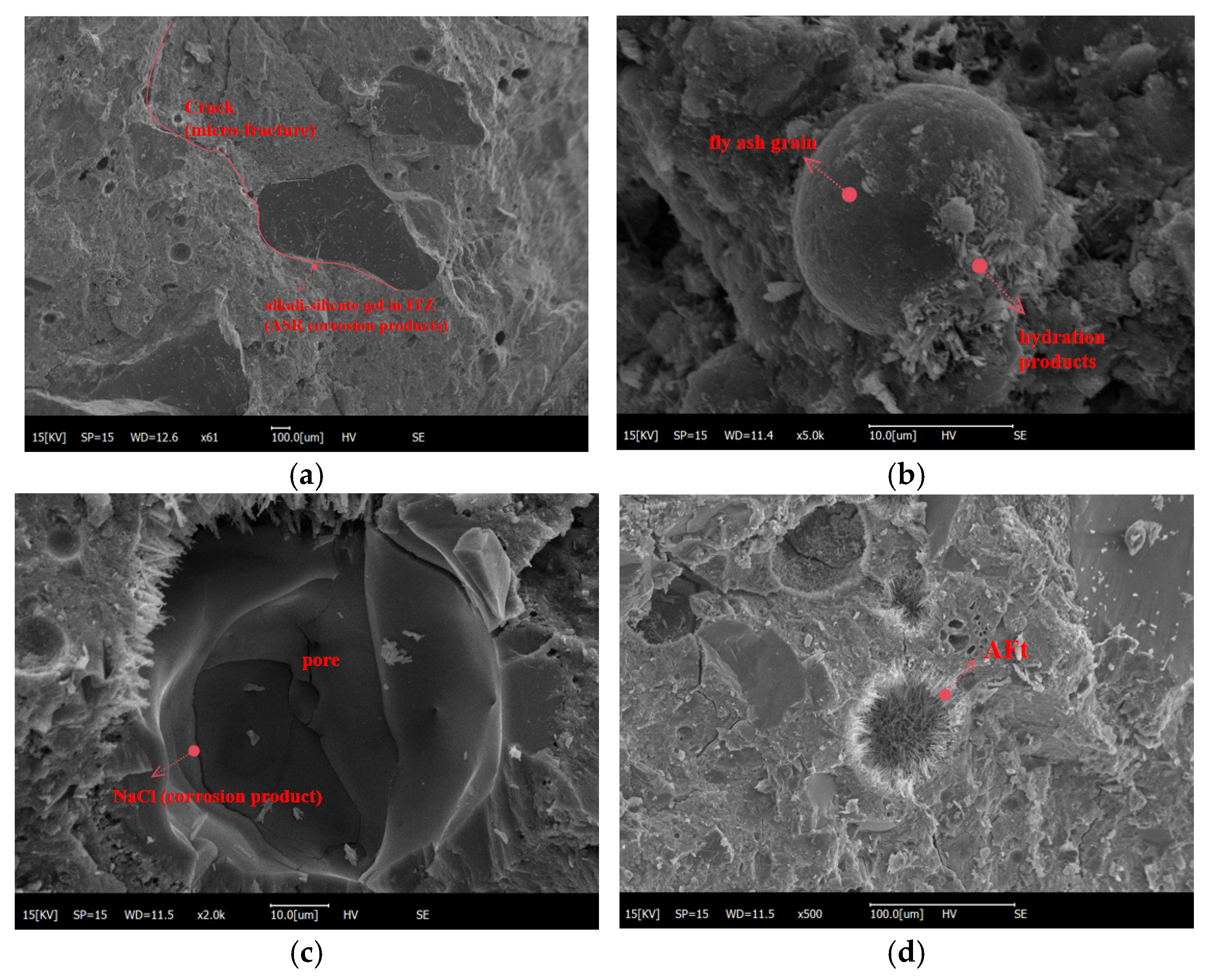

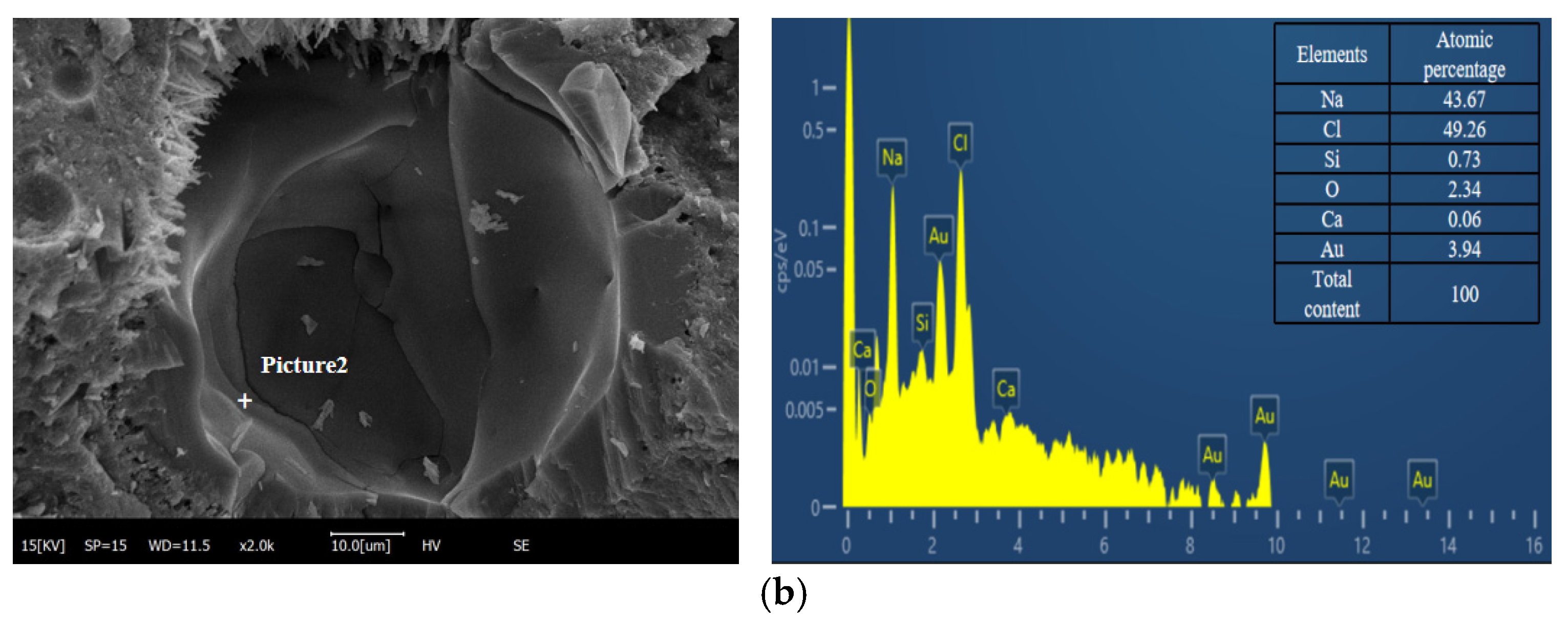
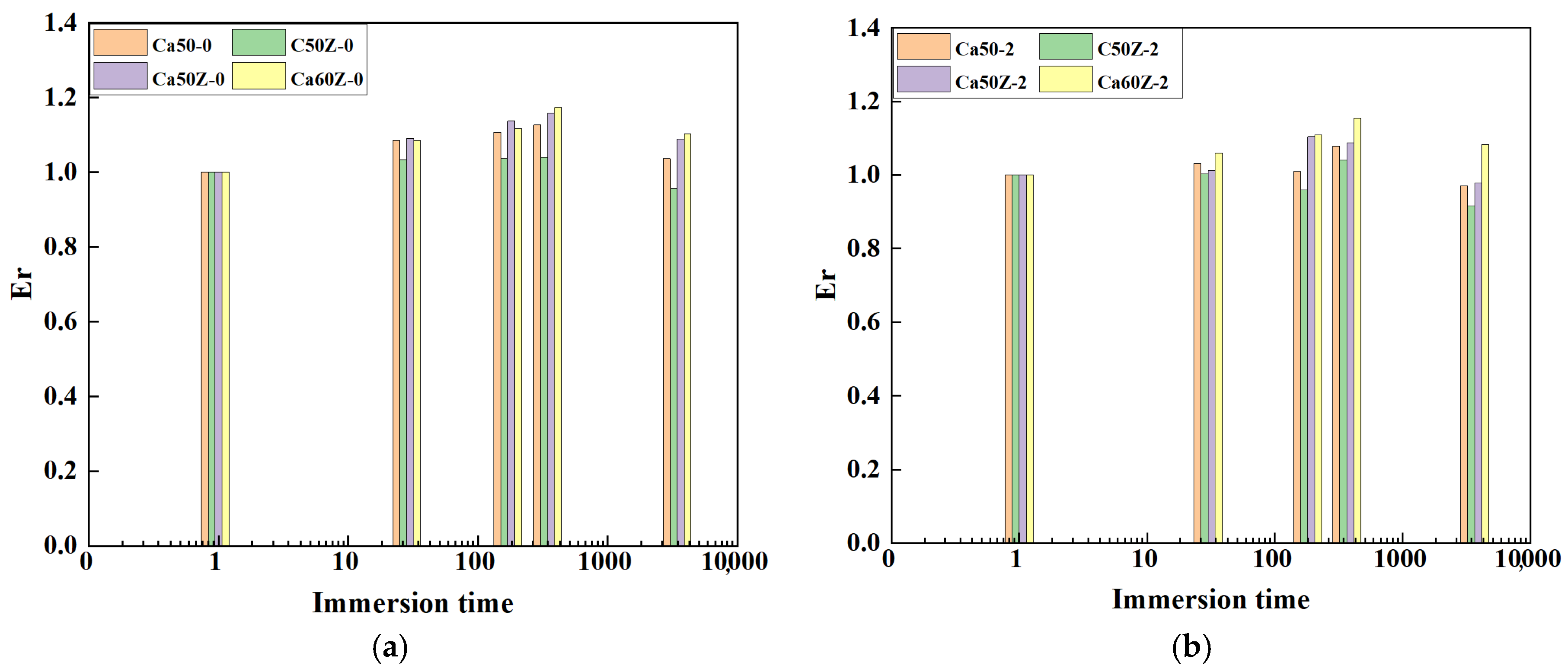

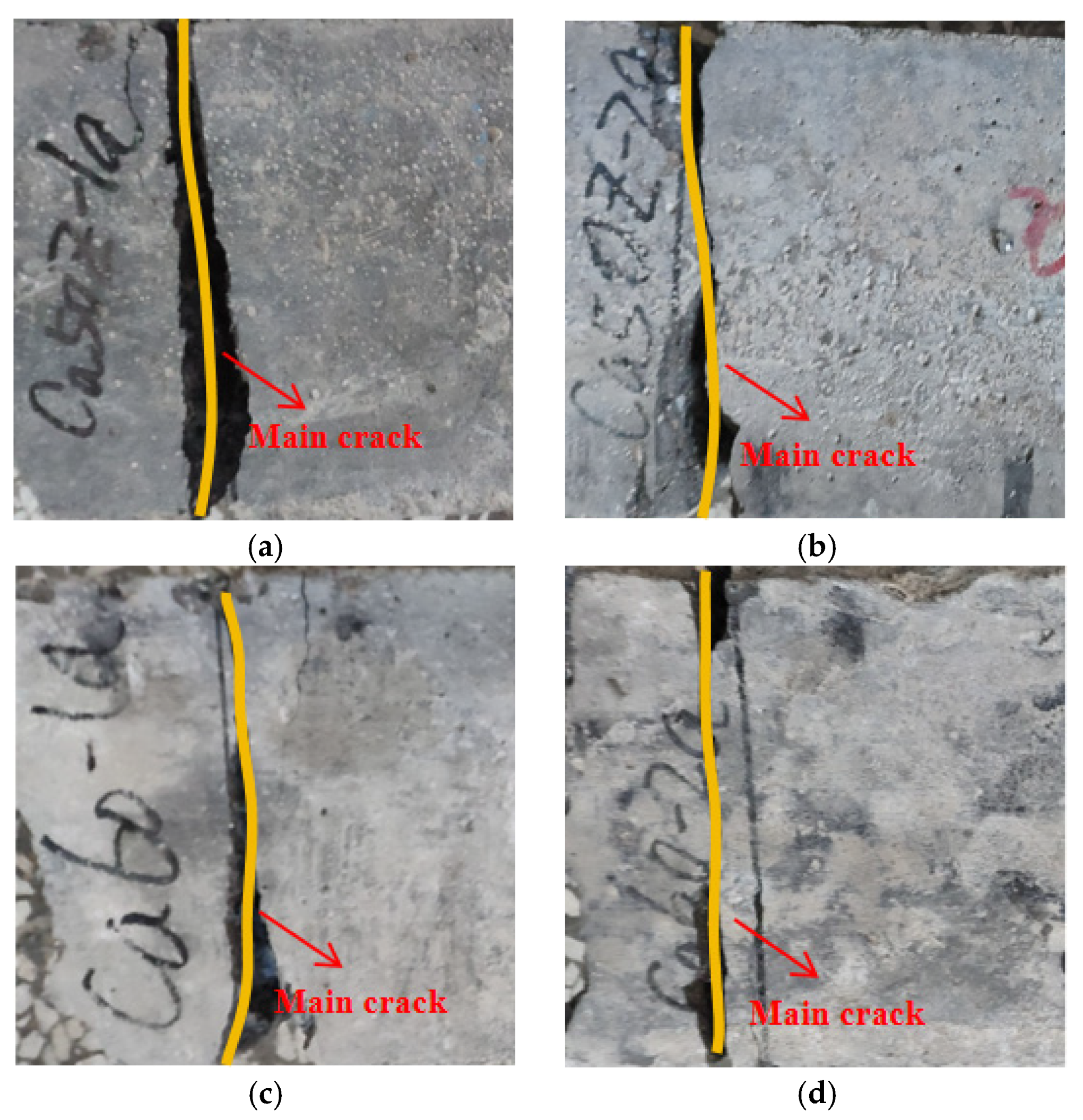
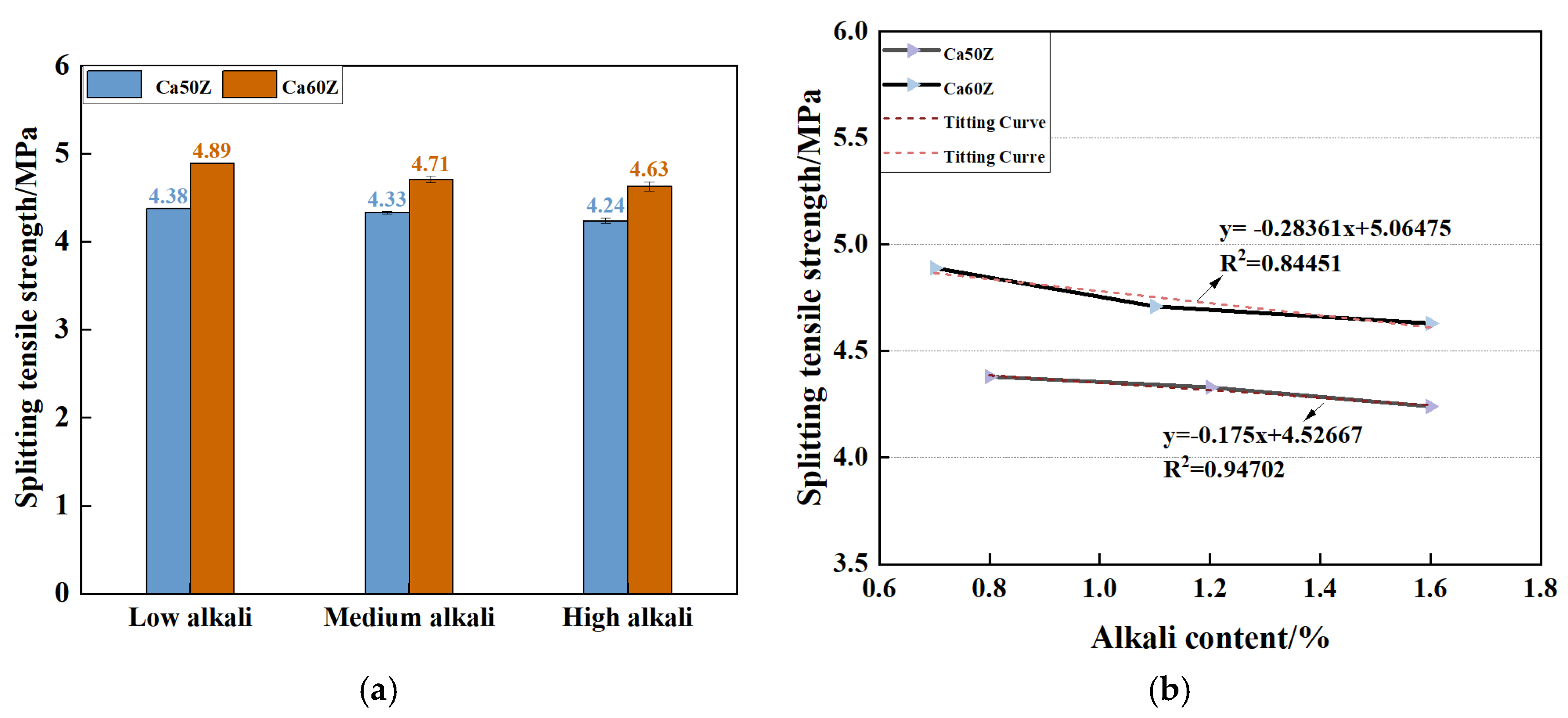


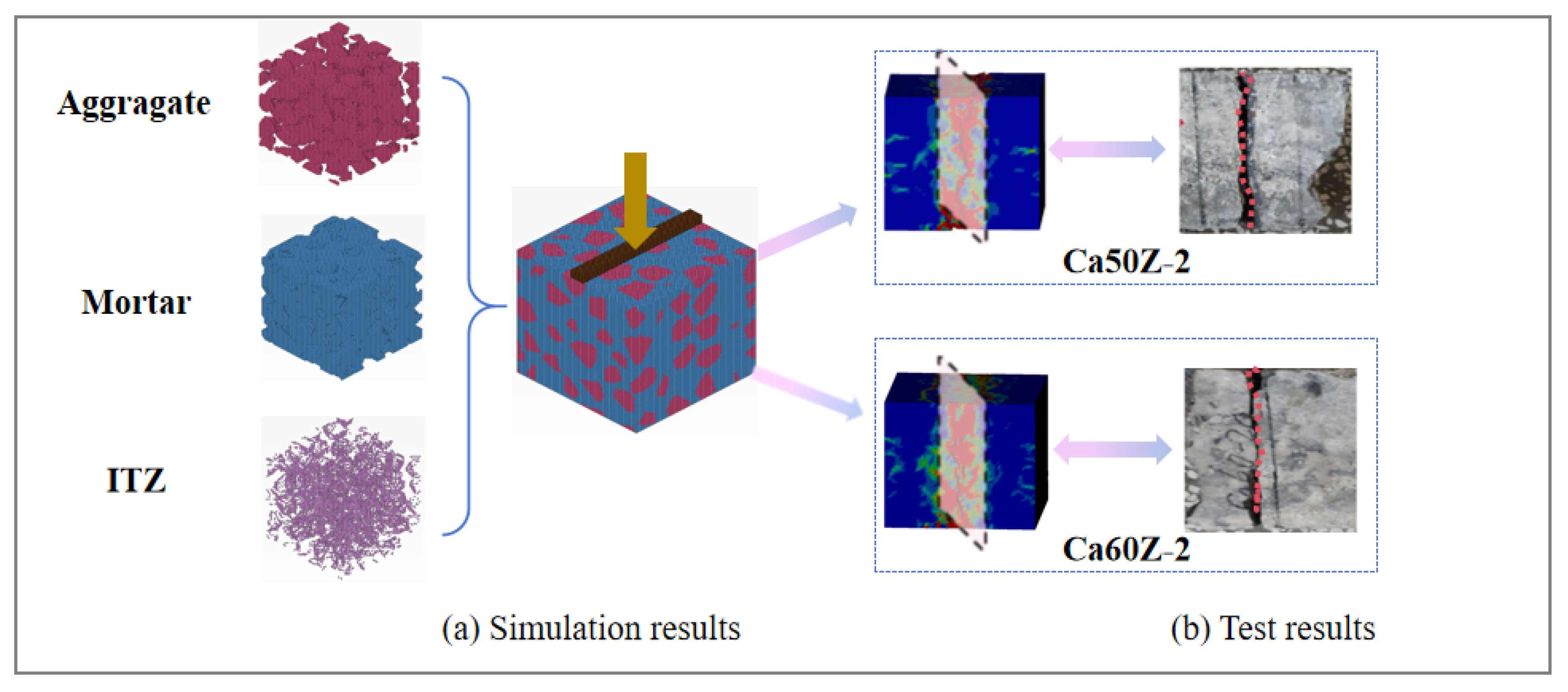

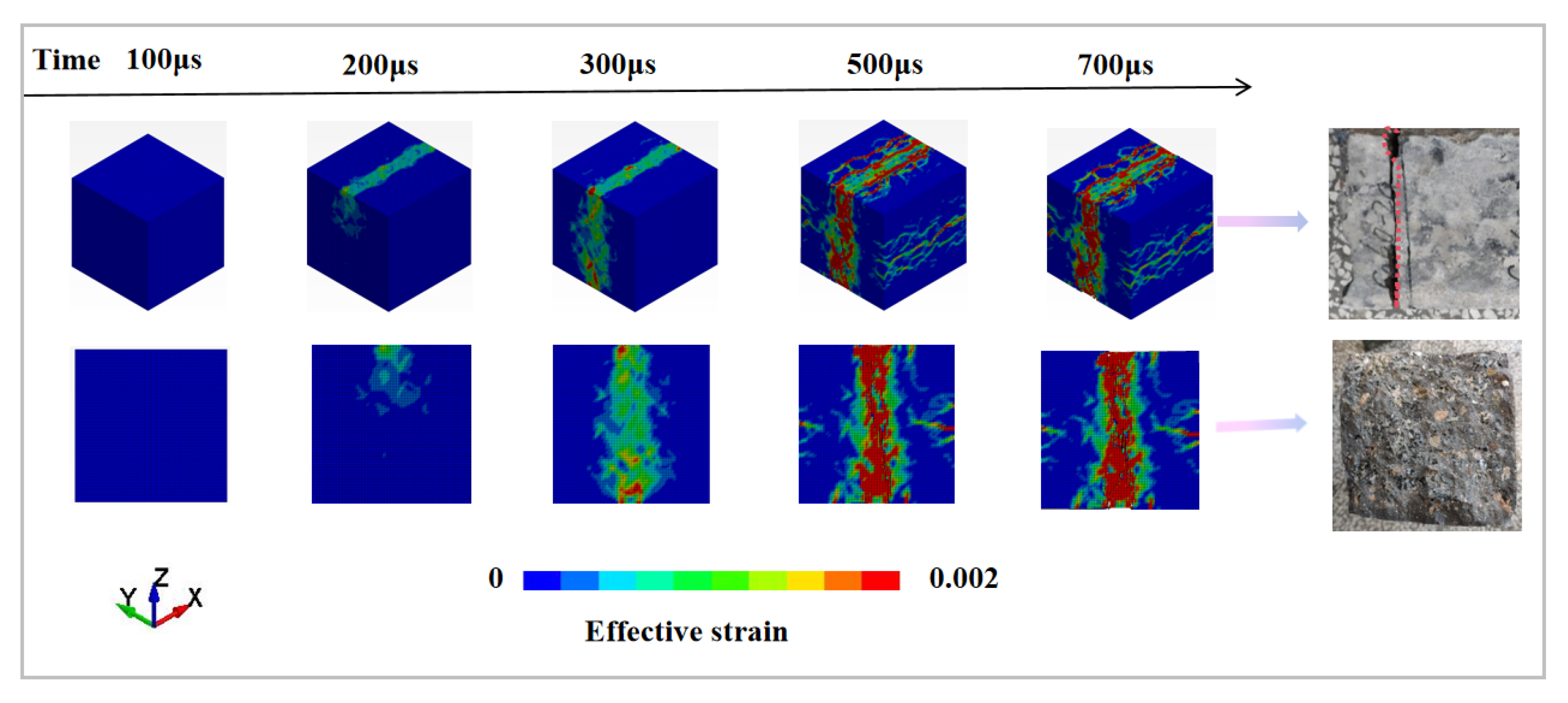
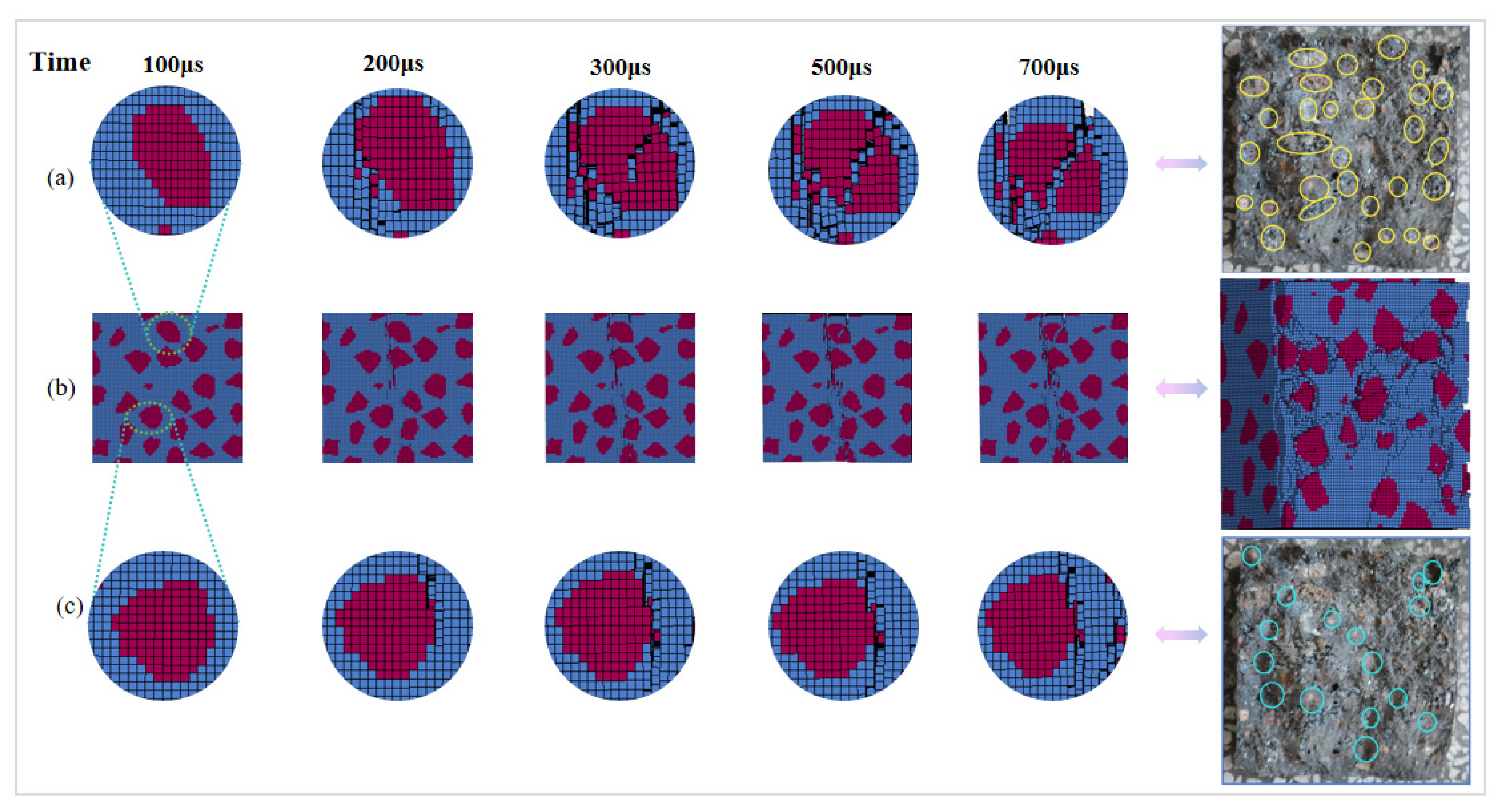

| Type | Standard Consistency/% | Initial Setting Time/min | Final Setting Time/min | Fineness /% | Specific Surface Area/m2·kg−1 | Compressive Strength/MPa | Flexural Strength/MPa | ||
|---|---|---|---|---|---|---|---|---|---|
| 3 Days | 28 Days | 3 Days | 28 Days | ||||||
| Cement | 26 | 145 | 220 | 0.8 | 350 | 21.8 | 49.0 | 5.6 | 7.8 |
| Constituents | Cement | FA | GGBFS | SF |
|---|---|---|---|---|
| Na2O/% | 0.24 | 0.63 | 0.27 | 1.03 |
| K2O/% | 0.59 | 1.35 | 0.40 | 2.00 |
| (Na2O + 0.658 K2O)/% | 0.63 | 1.52 | 0.53 | 2.35 |
| No. | Material/kg·m−3 | Na2Oeq /% | W/B | fc/MPa | ||||||||||
|---|---|---|---|---|---|---|---|---|---|---|---|---|---|---|
| Cement | FA | GGBFS | SF | Fine | Coarse | a | Z | Water Reducer | Water | 28 Days (in Normal Environment) | 3650 Days (in Brine Environment) | |||
| Ca50-0 | 325 | 60 | 100 | 15 | 741 | 1159 | 0.25 | - | 10 | 150 | 0.8 | 0.30 | 52.4 | 65.4 |
| Ca50-1 | 325 | 60 | 100 | 15 | 741 | 1159 | 0.25 | - | 10 | 150 | 1.3 | 0.30 | 54.0 | 58.6 |
| Ca50-2 | 325 | 60 | 100 | 15 | 741 | 1159 | - | - | 10 | 150 | 1.8 | 0.30 | 53.2 | 58.9 |
| C50Z-0 | 325 | 60 | 100 | 15 | 741 | 1159 | - | 33 | 10 | 127 | 0.8 | 0.25 | 59.6 | 61.4 |
| C50Z-1 | 325 | 60 | 100 | 15 | 741 | 1159 | - | 33 | 10 | 127 | 1.3 | 0.25 | 51.0 | 62.4 |
| C50Z-2 | 325 | 60 | 100 | 15 | 741 | 1159 | 0.25 | 33 | 10 | 127 | 1.8 | 0.25 | 55.5 | 60.3 |
| Ca50Z-0 | 325 | 60 | 100 | 15 | 741 | 1159 | 0.25 | 33 | 10 | 127 | 0.8 | 0.25 | 60.6 | 70.1 |
| Ca50Z-1 | 325 | 60 | 100 | 15 | 741 | 1159 | 0.25 | 33 | 10 | 127 | 1.2 | 0.25 | 61.0 | 66.2 |
| Ca50Z-2 | 325 | 60 | 100 | 15 | 741 | 1159 | 0.268 | 33 | 10 | 127 | 1.6 | 0.25 | 52.4 | 65.4 |
| Ca60Z-0 | 322 | 80 | 118 | 16 | 739 | 1155 | 0.268 | 33 | 13.4 | 127 | 0.7 | 0.24 | 54.0 | 58.6 |
| Ca60Z-1 | 322 | 80 | 118 | 16 | 739 | 1155 | 0.268 | 33 | 13.4 | 127 | 1.1 | 0.24 | 53.2 | 58.9 |
| Ca60Z-2 | 322 | 80 | 118 | 16 | 739 | 1155 | 0.25 | 33 | 13.4 | 127 | 1.6 | 0.24 | 59.6 | 61.4 |
| Constituents | NaCl | Na2SO4 | MgSO4 | CaSO4 | Ca(HCO3)2 | K2SO4 | NaCl | Na2SO4 |
|---|---|---|---|---|---|---|---|---|
| Quantity | 208.98 | 43.1 | 5.48 | 1.21 | 0.25 | 0.09 | 208.98 | 43.1 |
| Immersion Time | Er | |||||||
|---|---|---|---|---|---|---|---|---|
| Ca50-0 | Ca50-2 | C50Z-0 | C50Z-2 | Ca50Z-0 | Ca50Z-2 | Ca60Z-0 | Ca60Z-2 | |
| 0 | 1.0000 | 1.0000 | 1.0000 | 1.0000 | 1.0000 | 1.0000 | 1.0000 | 1.0000 |
| 28 | 1.0852 | 1.0319 | 1.0327 | 1.0028 | 1.0902 | 1.0133 | 1.0848 | 1.0596 |
| 180 | 1.1057 | 1.0100 | 1.0356 | 0.9603 | 1.1368 | 1.1040 | 1.1162 | 1.1087 |
| 365 | 1.1263 | 1.0779 | 1.0392 | 1.0401 | 1.1580 | 1.0871 | 1.1736 | 1.1550 |
| 3650 | 1.0362 | 0.9700 | 0.9561 | 0.9153 | 1.0890 | 0.9784 | 1.0820 | 1.0830 |
| Immersion Time | Splitting Tensile Strength/MPa | |||||||
|---|---|---|---|---|---|---|---|---|
| Ca50-0 | Ca50-2 | C50Z-0 | C50Z-2 | Ca50Z-0 | Ca50Z-2 | Ca60Z-0 | Ca60Z-2 | |
| 0 | 3.72 | 3.83 | 3.77 | 4.2 | 3.62 | 3.92 | 4.26 | 4.29 |
| 28 | 4.5 | 3.97 | 3.93 | 4.3 | 4.53 | 3.98 | 5.02 | 4.52 |
| 180 | 4.8 | 3.87 | 3.95 | 4.01 | 4.61 | 4.56 | 5.14 | 4.78 |
| 365 | 4.92 | 4.17 | 3.96 | 4.38 | 4.63 | 4.31 | 5.48 | 5.06 |
| 3650 | 4.58 | 4.13 | 4.15 | 4.32 | 4.38 | 4.24 | 4.89 | 4.63 |
| Aggregate | Mortar | ITZ | ||||
|---|---|---|---|---|---|---|
| Ca50-0 | Ca60-0 | Ca50-0 | Ca60-0 | Ca50-0 | Ca60-0 | |
| ρ/g·cm−3 | 2680 | 2680 | 2500 | 2550 | 2500 | 2550 |
| fc/MPa | 128 | 128 | 6.7 | 6.9 | 16.2 | 17.4 |
| fst/MPa | 42.7 | 42.7 | 3.4 | 3.5 | 1.2 | 1.4 |
| The Splitting Tensile Strength of the Numerical Simulation/MPa | The Splitting Tensile Strength of the Test/MPa | Error/% | |
|---|---|---|---|
| Ca50Z-0 | 4.42 | 4.38 | −0.91 |
| Ca50Z-2 | 4.19 | 4.24 | +1.18 |
| Ca60Z-0 | 4.78 | 4.89 | +2.25 |
| Ca60Z-2 | 4.66 | 4.63 | −0.65 |
Disclaimer/Publisher’s Note: The statements, opinions and data contained in all publications are solely those of the individual author(s) and contributor(s) and not of MDPI and/or the editor(s). MDPI and/or the editor(s) disclaim responsibility for any injury to people or property resulting from any ideas, methods, instructions or products referred to in the content. |
© 2024 by the authors. Licensee MDPI, Basel, Switzerland. This article is an open access article distributed under the terms and conditions of the Creative Commons Attribution (CC BY) license (https://creativecommons.org/licenses/by/4.0/).
Share and Cite
Wang, F.; Yu, H.; Ma, H.; Cheng, M.; Guo, J.; Zhang, J.; Liu, W.; Gao, W.; Tao, Q.; Guo, J. Splitting Tensile Mechanical Performance and Mesoscopic Failure Mechanisms of High-Performance Concrete under 10-Year Corrosion from Salt Lake Brine. Buildings 2024, 14, 1673. https://doi.org/10.3390/buildings14061673
Wang F, Yu H, Ma H, Cheng M, Guo J, Zhang J, Liu W, Gao W, Tao Q, Guo J. Splitting Tensile Mechanical Performance and Mesoscopic Failure Mechanisms of High-Performance Concrete under 10-Year Corrosion from Salt Lake Brine. Buildings. 2024; 14(6):1673. https://doi.org/10.3390/buildings14061673
Chicago/Turabian StyleWang, Fang, Hongfa Yu, Haiyan Ma, Ming Cheng, Jianbo Guo, Jinhua Zhang, Weifeng Liu, Weiquan Gao, Qinghua Tao, and Juan Guo. 2024. "Splitting Tensile Mechanical Performance and Mesoscopic Failure Mechanisms of High-Performance Concrete under 10-Year Corrosion from Salt Lake Brine" Buildings 14, no. 6: 1673. https://doi.org/10.3390/buildings14061673





